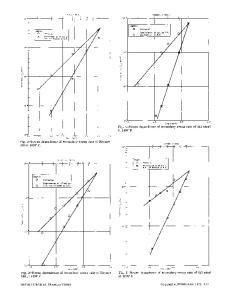Fracture, fatigue, and creep of nanotwinned metals
- PDF / 811,586 Bytes
- 7 Pages / 585 x 783 pts Page_size
- 43 Downloads / 659 Views
Introduction Over the past decade, the fabrication of nanotwinned (NT) metals with ultrahigh strength and good ductility has been recognized as a remarkable breakthrough in the area of metallic structured materials. These materials exhibit a hierarchical microstructure, with a large number of highly organized nanoscale twins embedded within micron- or submicron-sized grains1,2 (Figure 1). Twin boundaries (TBs) with low energy and high symmetry not only act as obstacles to dislocation motion, but they also store a high density of mobile dislocations, leading to macroscopic hardening and strengthening, as well as improved ductility of NT materials compared to their nanocrystalline counterparts.2,3 Experimental studies1,2,4–14 have shown that NT metals possess excellent mechanical properties, such as ultrahigh strength, good ductility, large fracture toughness, remarkable fatigue resistance, and creep stability. Fabrication methods for NT metals include electrodeposition,1,2 physical vapor deposition (e.g., magnetron sputtering)5,6 and dynamic plastic deformation (DPD) (a synthesis technique for bulk nanostructured metals based on plastic deformation at high strain rates or low temperatures).10,11 The characteristic length scale of the twin structures produced from deposition methods can be tuned to below 10 nm.
Figure 1a–b shows typical transmission electron microscope (TEM) images of electrodeposited NT Cu with equiaxed grains1 and magnetron sputtered epitaxial Ag with columnar grains,2 respectively. The twin structures produced by DPD are deformation twins that are emitted from grain boundaries (GBs) or free surfaces during severe plastic deformation. Figure 1c shows TEM images of a three-order twinned structure in a twinning-induced plasticity (TWIP) steel sample via surface mechanical attrition treatment.15 It is also interesting that a gradient NT structure can be generated by subjecting a TWIP steel bar to torsion.16 For more details and discussions of growth and deformation twins in NT metals, see the review article by Beyerlein et al.17 and viewpoint paper by Mahajan.18 Plenty of experimental, computational, and theoretical studies1,2,4–16,19–33 have been conducted to investigate the mechanisms of plastic deformation in NT metals (e.g., interactions between TBs and dislocations) and related size effects (e.g., the influence of TB spacing on the strength and ductility of materials). Some of the recent advances in this area have been reviewed in the literature.34,35 Understanding the damage tolerance (such as fracture and fatigue resistance) and time-dependent deformation behaviors (such as creep stability) of NT metals are essential for
Xiaoyan Li, Centre for Advanced Mechanics and Materials, Applied Mechanics Laboratory, Department of Engineering Mechanics, Tsinghua University, China; [email protected] Ming Dao, Department of Materials Science and Engineering, Massachusetts Institute of Technology, USA; [email protected] Christoph Eberl, Laboratory for Micro- and Materials Mechanics, Institute for M
Data Loading...











